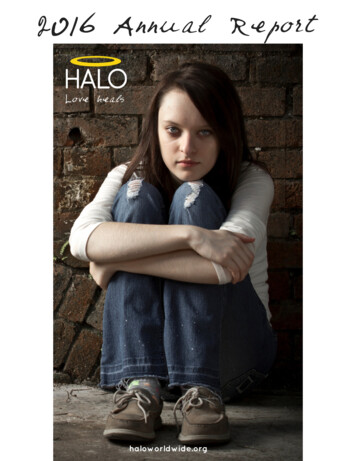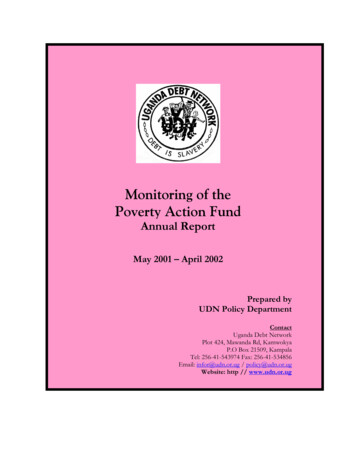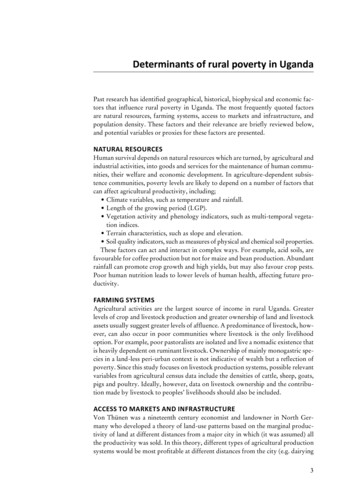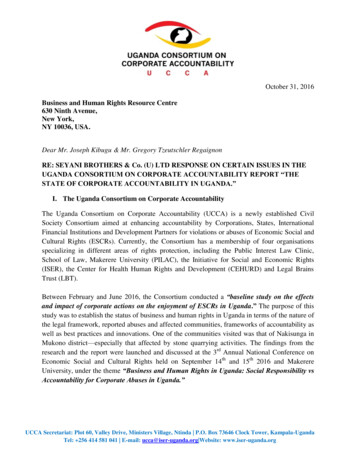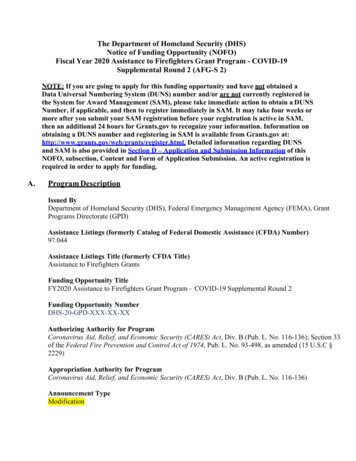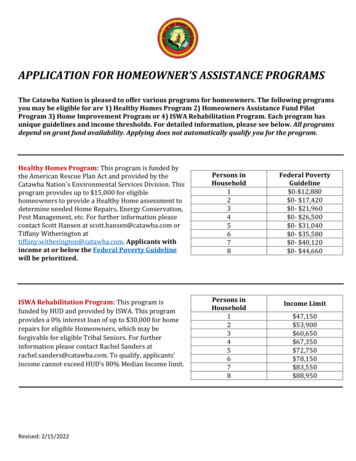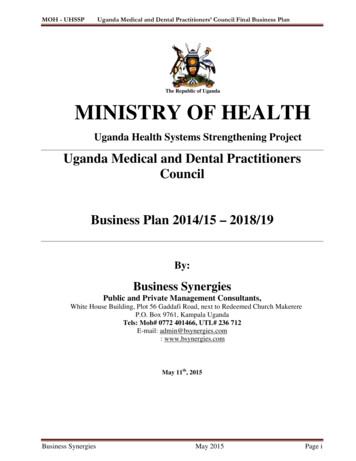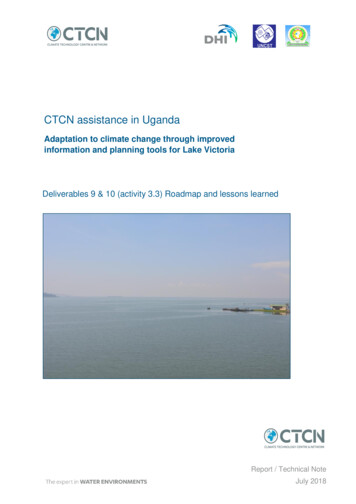
Transcription
CTCN assistance in UgandaAdaptation to climate change through improvedinformation and planning tools for Lake VictoriaDeliverables 9 & 10 (activity 3.3) Roadmap and lessons learnedReport / Technical NoteJuly 2018
This report has been prepared under the DHI Business Management Systemcertified by Bureau Veritas to comply with ISO 9001 (Quality Management)Approved bybfvs5ygq.s3r.doc / 19-07-2018
CTCN assistance in UgandaAdaptation to climate change through improvedinformation and planning tools for Lake VictoriaDeliverables 9 & 10 (activity 3.3) Roadmap andlessons learnedPrepared forUNEPRepresented byMr. Manfredi CaltagironeProject managerSílvia LeiriãoQuality supervisorOluf Zeilund JessenPrepared bySílvia Leirião, Christine Kaaya, Niels Riegels, and Oluf Z.JessenProject number11820007Approval date19th of July 2018RevisionFinal versionClassificationRestrictedDHI Agern Allé 5 DK-2970 Hørsholm DenmarkTelephone: 45 4516 9200 Telefax: 45 4516 9292 dhi@dhigroup.com www.dhigroup.com
bfvs5ygq.s3r.doc / 19-07-2018
CONTENTS1Brief introduction . 22Lessons learned . 52.12.22.32.4Gender mainstreaming in IT based TAs . 5Stakeholder mapping feedback loop . 5Mentoring task . 6Advice to advisers . 63Roadmap for regional transfer and scaling up . 9i
Acronyms and FGDPGFSADIUCEAJAXALMCSLVBCLVEMPMAAIFMUSTMWE CCDMWE SSDMWE MAVCIWCRPWRISAgricultural Stress IndexClimate Forecast SystemCopernicus Global Land ServiceIntergovernmental Panel on Climate Change Science Information NetworkCoordinated Regional Climate Downscaling ExperimentClimate Technology Centre & NetworkEast African CommunityEffective Drought IndexFood and Agriculture Organization of the United NationsGreen Climate FundGross Domestic ProductGlobal Food Security Support Analysis DataInter-University Council for East AfricaJapanese Aerospace Exploration AgencyLand Monitoring Core ServiceLake Victoria Basin CommissionLake Victoria Environmental Management ProjectMinistry of Agriculture, Animal Industry and FisheriesMbarara University of Science TechnologyMinistry of Water and Environment Climate Change DepartmentMinistry of Water and Environment Support Services DepartmentMinistry of Water and Environment Directorate of Water ResourcesManagementNational Association of Professional EnvironmentalistsNational Aeronautics and Space AdministrationNile Basin InitiativeNational Centers for Environmental PredictionNational Designated EntityNormalized Difference Vegetation IndexNile Equatorial Lakes Subsidiary Action ProgramNational Oceanic and Atmospheric AdministrationMaking Earth System Data Records for Use in Research EnvironmentsMinistry of Gender Labour and Social DevelopmentResilient Africa NetworkRadiative Concentration PathwaySocioeconomic Data and Applications CenterStandardised Precipitation IndexSpecial Report on Emissions ScenariosSTEPUP Standard LimitedStandardised vegetation indexSoil Water IndexTropical Rainfall Measuring MissionUganda National Council for Science and TechnologyUnited Nations Environment ProgrammeUnited Nations Framework Convention on Climate ChangeUganda National Meteorology AuthorityVegetation Condition IndexWorld Climate Research ProgrammeWater Resources Information Systemii
Activity 3.3 Roadmap and lessons learnedThe technical assistance is being implemented through three main activities forming the scopeof work and key deliverables: Activity 1 – Stakeholder outreach; Activity 2 – Data access, modelrefinement, and development of guidelines for decision support; and Activity 3 – Disseminationand outreach. For more background information please refer to Activity 1 & 2 reports.The main purpose of Activity 3 is to help stakeholders make use of the components of thetechnical assistance, and the formulated output from Activity 3 is:Increased national and regional capacity for planning with focus on climate changeimpact on Lake Victoria. Roadmap describing recommendations for national and regionalupscaling.The four activities and deliverables of Activity 3 are the following: Activity 3.1 – Second national workshop to inform relevant stakeholders and organisations inUganda about the outputs of the CTCN assistance. Activity 3.2 – Technical training to provide detailed knowledge and capacity in using theproducts of the technical assistance in Uganda on an ongoing basis. Activity 3.3 – Regional dissemination to all countries in the Lake Victoria region aims atproviding awareness and knowledge of the technology to relevant organizations within the LakeVictoria region. This activity includes: oRegional dissemination to key organisations within the Lake Victoria basin throughthe council of ministers’ meetings by the LVBC; dissemination of materials to allrelevant national and regional stakeholders through LVBC web site.oLessons learned report; Roadmap documentation describing recommendations forregional transfer of the technology and scaling up within future projects; includingan evaluation of funding options through regional partnerships and donors for postresponse interventions.Activity 3.4 Evaluation and Learning will produce a monitoring and evaluation plan to monitorand evaluate the timeliness and appropriateness of the implementation; the update of theCTCN Impact Description; and a closure report.This report contains the key deliverables under Activities 3.3. The first chapter provides a verybrief background to the Climate Technology Centre and Network (CTCN) technical assistanceand the second chapter lessons learned throughout the technical assistance includingstakeholder recommendations. Finally, the third chapter lays out the roadmap that presentsregional transfer and scaling up potential opportunities each matched with the appropriatepotential funding option.1
1 Brief introductionUpon a request by the Lake Victoria Basin Commission (LVBC), the CTCN funded technicalassistance on “Adaptation to climate change through improved information and planning toolsfor Lake Victoria”. The technical assistance kicked off in June 2017 with the objective tostrengthen planning in the water resources and energy sectors in Uganda, at both long-term andseasonal timescales. In February 2018 a web portal was deployed making the data, information,tools and guidelines produced freely accessible online to all national stakeholders. The webportal titled Adaptation to Climate Change portal – Lake Victoria and Uganda1, constitutesthe platform provided by the technical assistance used to deliver embedded applications,namely:Data and information – application providing free access to near real time data and informationof relevance for the CTCN assistanceBasin planning – supporting basin planning through evaluation of existing and new investments,climate change and population pressureDrought assessment – supporting the identification of areas with drought hazard and evaluatingthe impact on vulnerable sectors or areasRDM tool and decision-making guidelines –supporting the decision process taking theuncertainty associated with climate change into considerationReporting – application to support dissemination of reports or bulletins to stakeholdersFigure 1Screenshot of the home page of the web portal displaying the introductory welcomemessage, the link to the guidelines document and the four data and tool applications.Simultaneously, the LVBC Water Resources Information System has been updated with staticdata consisting of climate change projections, and a procedure has been put in place to outlinethe import of seasonal forecast data monthly. This procedure is described in Deliverable 6(activity 2.2) Testing and demonstration report.1Portal address: http://www.flooddroughtmonitor.com2
Engagement and preparation meetings with stakeholder institutions in Uganda – 5 to 9 ofFebruary 2018 – followed by a testing, validation and demonstration workshop – 21 and 22 ofMarch 2018 – with LVBC staff held at the UNCST premises.ththstndFrom the 5th to 7th of June 2018 the final workshop and technical training took place in Entebbeas a residential event. Both the workshop and technical training were attended by the sameparticipants, a total of 21 participants from 9 institutions.A series of information sheets consisting of a two-page note on different aspects related to thedeliverables were sent every week via email. This weekly interaction sprung a community ofinterested parties within each organization. It was also used for testing and demonstrationpurposes.Activity 3 ended on the 30th of June bringing this technical assistance to closure.3
4
2 Lessons learnedThe following subchapters present the lessons learned during this technical assistance (TA).The expectation is that these will be applied when defining and structuring future responses tosimilar CTCN technical assistances as well as projects nationally and regionally that follow.2.1 Gender mainstreaming in IT based TAsThe importance of gender mainstreaming was not obvious from the beginning as this technicalassistance and its outputs do not require any field incursions or direct community interventionsin climate change adaptation. The deliverables are part of an online platform and the datacentricity and IT nature of the implementation seemed to be far from tangible gender sensitiveimpacts.Our gender expert was brought in during the middle of Activity 1, and her main role in thetechnical assistance was to follow the final workshop and technical workshop which lasted threedays to monitor and report on gender dimensions. The application of our gender expert’s gendersensitivity assessment methodology resulted in much more than that: Initial intervention after the official opening of the event was crucial to introduce theparticipants to the component and putting them at ease, framing it from the start asbeing about freedom of speech for both female and male genders in general; this leadto increased efficiency in stakeholder interventions during the events; Raising awareness to gender issues, providing take-away advice to participatingstakeholders; Perception of going to the portal to see the future not the past must be addressed byemphasizing that the past informs the future and demonstrating with clear examples,especially looking at the individual level, men and women; Technical refinements to the portal were collected, namely including datasets withgender breakdown, and including gender in weekly communication and adding advice toadvisors that include female targeted elements; highlighting the importance of pictorialssuch as the application buttons in the homepage; By the end of the event, stakeholders were pointing out the lack of female professionalsin meteorology and hydrology related disciplines.The input of the gender expert, though initially designed thinking only of capacity building, turnedout to deliver very important recommendations for content and technical components of theportal, and it is strongly believed if more time and budget had been allocated, the input couldhave potentially influenced functionality. The integration of gender aspects in the usage of thesystem was accomplished through the capacity building and training component.It is believed that if gender experts have their time provisions extended, even for a technologynatured TA such as this one, many more benefits can be accrued.2.2 Stakeholder mapping feedback loopThe success of this technical assistance was dependent on the engagement of identifiedstakeholders. The role of the UNCST was unequivocally crucial, and we managed to reach outto the stakeholders which are not only getting the most out of the deliverables but also beinglocal champions in the use of the portal. These are the Uganda National Meteorological Agency,5
the Climate Change Department of the Ministry of Water and Environment, the GIS Unit of theMinistry of Energy and Mineral Development, the National Association of ProfessionalEnvironmentalists (NAPE). Two universities MUST and MUSPH were also engaged howeverthe trickling of usage of the portal within class room or innovators would have to be ascertainedfollowing the training and further supported.The LVBC was very engaged in the persons of Water Resources Management Officer and theWRIS operator and IT expert. The procedure created to allow import of seasonal forecast intothe WRIS is in effect. However, as part of the roadmap the need to enhance the WRIS isproposed.Despite efforts made in Activity 1 – Stakeholder outreach, the Ministry of Agriculture, AnimalIndustry and Fisheries was not included and is recognized as the missing key stakeholder in thetechnical assistance.Therefore, to prevent this from happening in the future, it is suggested that a stakeholdermapping review task is added to the second activity of the scope of work, to make allowance forany extra efforts needed to in case there are stakeholders missing or not yet successfullyengaged at that stage in the assistance. Bringing in a new stakeholder will be easier in themiddle of the implementation than at the end before the final workshop and technical training. Arobust stakeholder review task with allowance for 2 days of work and a potential extra mission,in the middle of Activity 2 would be most efficient in adding to the permanent and sustained usercommunity of the portal.2.3 Mentoring taskClosing the technical assistance was Activity 3 – Dissemination and outreach, designed to helpstakeholders make use of the different components of the technical assistance, with a workshopand a technical training event.Through stakeholder feedback it has been concluded that as part of this activity an additionaltime for mentoring interventions in the form of institutional one-on-one meetings after the finaltraining, would greatly increase the uptake of the tools and would be a minor expenditure thatcould generate great impact on sustainability.The impact of this task comprising skype mentoring and institutional workshops would be twofold. Firstly, it would help combat the usual and existing perception that “help is gone” after thelast training. Changing this perception that the last training is the last chance for help, woulddeeply impact the user community’s collective mindset, and increase sustained use of thetechnology.The challenge would then be how to cap the mentoring task to an appropriate time following thefinal training event: an example could be minimum of 1 field intervention and 1 days’ worth ofskype mentoring over a period of 3 months.Learning and incorporating a new tool into our everyday work is very hard to do, however withthe existing need for the deliverables of this technical assistance, the first step has been taken.The second and very cost efficient step would be the push needed for effective integration of thenew tool. Within the Roadmap a proposed project responds to this need.2.4 Advice to advisersDissemination has been a great focus of this technical assistance and it has been successfullyaddressed, with the development of a reporting application with automatic update and emailingof reports to users.6
In the future, when carrying out work based on providing data and information, along with thedissemination task, it is recommended that a section on advisories is added. This additionalcomponent within the dissemination activity of the assistance would make room for focused andtargeted preparation of written advisories for advice providers to use, in parallel with the usercentric reporting experience.This component would focus on providing “Advice to advisers” through the implementation ofguidelines for how to use the outcome for specific purposes.Advisers being the consumers of portal data and information with disseminating mandatesthemselves. A straight forward example is a Ministry of Agriculture official, or a member of aCivil Society Organization, who provides advice to farmers in rural areas based on droughtindicators from the portal. Another one is for example, a Meteorological Authority official whouses seasonal forecasts from the portal as a complement to the ones produced by her/his office,and needs to relay the data and information to a team of Meteorologists for further analysis.Additionally, the advisory section for advice to advisers would be a perfectly placed deliverableto include and specifically address gender sensitive issues such as: Promote the use of female appropriate mechanisms for dissemination (women groups,appropriate time slots appropriate during the day, etc); Promote decision making that highlights the most preferred and economical rewardingto women; Make detailed recommendations for regional dissemination use of appropriate andgender sensitive media, language, mechanism (radio, tv).This component could be further complemented by training of champions who should be able tofurther advise and train other organisations.7
8
3 Roadmap for regional transfer and scaling upThis roadmap is a tool designed to guide post response interventions. It results from discussionswith key stakeholders nationally, regarding needs that can be met by scaling up the data,information and tools this assistance has delivered; and, discussions with the Lake VictoriaBasin Commission regarding regional transfer. The roadmap consists of a key focus; a portfolioof projects aligned with stakeholder needs; technical, regional transfer and scale uprecommendations; and proposed next steps.Roadmap focus Regional transfer and scaling up of the capacity building and technology within futureproposed projects and their conceptualization Recommendations and proposed next steps for technical improvements,sustainability and funding optionsRegional transfer and scaling upThe proposed projects are presented across the next pages, showing the key parameters for theconceptualization of each project, namely, background, stakeholders involved, deliverables(what and why), funding options, known risks and range for project size (rough estimates: small4 months, medium 6 months to 1 year, large over 1 year). All proposed projects are formulatedfor the first time and presented next. In some cases, lead institutions exist, in other cases thesehave not yet been identified. These are listed below: Decision making under uncertainty in agriculture in Uganda WRIS enhancement and capacity building with lessons learned from Uganda Development of MRV system for NDC Implementation Climate operational data enhancement for Uganda Adaptation to climate change portal from Uganda to Kenya, Tanzania, Rwanda andBurundi. Regional capacity building and gender mainstreamingBarrier for scaling upBy the end of this technical assistance the biggest achievement pointed out by all parties, ismultilevel buy-in, from high up management to very technical staff, ownership of the portalcreated, as well as a strong user community. Therefore, part of the conditions required forscaling up is in place: needs assessed and solutions found; portal implemented with data,information and tools; user community established; and projects wanted and drawn up. Thus far,the barrier has been identifying the correct funding option and allocation of resources to carryout the application process. The institutional setting and existing capacity is well understood anddoes not pose any barrier to the realistic implementation of the proposed projects. However,accessibility to funds jeopardizes the ability of the key stakeholders involved to bring thisroadmap to fruition.9
Project nameDecision making under uncertainty in agriculture in UgandaLeverageFlood & Drought Management Tools project funded by GEF through UNEPAdaptation to climate change portal - Lake Victoria and Uganda funded by CTCNStakeholdersUNMA; MAAIF; MWE CCD; NAPE UNCST; no lead identified.Background andobjectiveAgriculture is the most important economic sector in Uganda. Many of the stakeholdersengaged in the current technical assistance need to provide advice to farmers.Considering uncertainty at this level will place this stakeholder group at the forefront ofinnovation in climate technology.The main objective would be to add the ability to assess a crop growth module forevaluation of crop water demand and crop yield for agriculture seasonal planningDeliverablesExtension of the existing Lake Victoria and Uganda portal with access to the FAOAquaCrop model allowing users to calculate crop growth and retrieve results as cropwater demand and crop yield.Proposed scopeof workActivity 1 InceptionProject inception and kick off meetings. Stakeholder outreach and selection of usecases for decision making under uncertainty with focus on agriculture.Activity 2 ImplementationCarrying out the necessary web development to plug in the crop tool from the Flood &Drought UNEP project to the Lake Victoria and Uganda portal. Carrying out thedevelopment of the use cases entailing workshops (minimum 2 interventions of 1 day)and testing and application of the crop and RDM tools.Development of specific advisories, that are appropriate for farmers and gendersensitive, to disseminate the results from the use casesActivity 3 Training and mentoringA technical training (minimum 3 days) for selected staff within the key organizations(maximum 20 participants) will be organised with the objective of providing detailedknowledge and capacity in using the new crop application. Remote mentoring to bedone after the training (minimum of 2 days’ worth of skype mentoring over a period of 3months).Project sizerangeSmall (approx. 120,000 USD)Known risksInability to obtain workable use cases; unsuccessful engagement of agriculturestakeholders.Funding optionNational funding / To be determinedUseful assistance/submit-request10
Project nameWRIS enhancement and capacity building with lessons learned from UgandaLeverageDevelopment of a Water Resources Monitoring Information System (WRMIS) forMonitoring Surface Water, Groundwater and Water Quality including a GIS-basedDatabase for Land-use, Hydrology and Biodiversity in the Lake Victoria Basin, LVBC,EAC, 2014Flood & Drought Management Tools project funded by GEF through UNEPAdaptation to climate change portal - Lake Victoria and Uganda funded by CTCNStakeholdersLVBC (lead)Background andobjectiveAfter three years in operation of the WRIS system, many lessons have been learnedand enhancement and improvement is not only needed but required, to continuefostering exchange of data and information, users (such as with any IT software) needcontinuous added value and need to feel like technology is up to date.DeliverablesEnhanced WRIS with up-to-date technology, data, information and tools.Proposed scopeof workActivity 1 InceptionProject inception and kick off meetings. Engagement of high level and technical staff.Review of existing WRIS system. Review of country exchange of data. Review ofsystem operation roles. Technical specifications design, and data exchange rules andregulations.Activity 2 WRIS enhanced pilot systemIn this activity a pilot system will be quickly implemented to allow exposure to the newsystem from the beginning. Based on the current limitations of the WRIS, and the dataand tools which are now available, it is expected that the pilot system will be focusedon improvement of the User Interface with added functionality to allow comparison ofspatially distributed grids; added time series data analysis functionality similar to whathas been done in the Adaptation to climate change portal - Lake Victoria and Ugandaassistance; and added remote sensing data and information that is automatically andcontinuously updated also similarly to the leveraging previous projects.Activity 3 Refinement of specifications and methodology for testingRefining technical specifications, data exchange, rules and regulations, and operationalroles. Use cases for testing.Activity 4 Development and testing of the enhanced WRISBased on the refined technical specifications, in this activity the final version of theenhanced WRIS will be finalized. A testing phase at country level with specific usecases should be included.Activity 5 Capacity buildingTo run throughout the project: from a first intervention for training at each country inusing the pilot system; several national workshops to test and refine the specifications;minimum 2 technical training sessions at LVBC and 2 per country. High levelworkshops for approval of data exchange rules, operational roles and overall systembuy-in.Project sizerangeMedium (approx. up to 250,000 USD)to Large (approx. 250,000 USD)11
Known risksFinding the best solution for exchange of national data; setting up rules and regulationsapproved by the countries to guide the exchange.Funding optionTo be determinedUseful //lvbc.wris.info12
Project nameDevelopment of MRV system for NDC ImplementationLeverageAdaptation to climate change portal - Lake Victoria and Uganda, CTCNFlood & Drought Management Tools projectStakeholdersMWE – CCD (lead)Background andobjectiveArticle 13 of the 2015 Paris Agreement establishes the Enhanced TransparencyFramework (UNFCCC 2015). The framework was established to enable the tracking,comparing and understanding of national commitments worldwide to fight climatechange. The “transparency framework” requires countries to regularly provide: (i) Anational inventory of greenhouse gas emissions (by sources) and removals (by sinks) (ii)Information necessary to track progress toward achieving their Nationally DeterminedContribution (NDC) (iii) Information related to climate change impacts and adaptation (iv)information on financial, technology transfer and capacity building support needed andreceived and (v) information on any support they provide to developing countries.Thus, the need to develop a functional Measurement Reporting and Verification (MRV)system that will support the country in tracking the GHG Emissions, the amount ofresources coming into the country in terms of support and the number of climate changeactivities/interventions/projects happening in the countryDeliverablesFunctional MRV System in placeCapacity built for officers to operationalize the systemProposed scopeof workActivity 1 InceptionProject inception and kick off meeting. Outline of datasets to be improved, materialsand methods, as well as best practice methodologies.Activity 2 Stakeholder engagementIdentify the key public and private sector stakeholders necessary for its design,development and sustainability. Engage the MRV working group from the keyinstitutions, sectors and development partnersActivity 3 Capacity building needs and technical specificationsReview and determine the short, medium to long-term capacity building needs tosupport implementation of the MRV system and develop capacity building modules.Establish the scope and structure of the system including the data, models, techniquesand accounting methods, that are part of the Measurement, Reporting and Verification(MRV) systemActivity 4 Deployment and data testingEstablish the MRV system template. Run MRV system developed, monitor and reviewperformance, take note of challenges, design and implement improvement strategies.Design and conduct capacity building trainings and workshops on the implementationof the MRV systemProject sizeMedium (approx. up to 250,000 USD)Known risksLimited institutional collaboration, and release of required information might be asource of delays in development.13
Funding optionNational funding / To be determinedUseful linkshttp://www.ccd.go.ug/14
Project nameClimate and forecast data enhancement for UgandaLeverageFlood & Drought Management Tools project funded by GEF through UNEPAdaptation to climate change portal - Lake Victoria and Uganda funded by CTCNStakeholdersUNMA (lead); UNCST;Background andobjectiveThe Lake Victoria and Uganda portal developed as part of the current TA has broughtto the UNMA access to a wealth of data; and the UNMA as the mandated institution tocurate, manage and produce weather and climate related data has the uniquecapability to enhance it. The UNCST can leverage the scientific developmentcomponent of the project.DeliverablesImproved quality of the available climate forecast data, where the specific details willhave to be decided but it could include bias-correction of climate forecast based onground stations, adding performance indicators etc.Proposed scopeof workActivity 1 InceptionProject inception and kick off meeting. Outline of datasets to be improved, materialsand methods, as well as best practice methodologies. Setup of online communicationstructure to facilitate safe and sound exchange of national data and information to beused, as well as efficient IT development framework. Outline of data testingmethodology.Activity 2 Methodological testActivation of the communication and testing of the methodology set out together withthe UNMA with pilot dataset enhancement case. Meetings potentially in Uganda andDenmark. Evaluation of data performance. Refinement of materials and methods andmethodological approach.Activity 3: Capacity building for UNMA staff in numerical modelling, tailored productsdevelopment, seasonal
DHI Agern Allé 5 DK-2970 Hørsholm Denmark Telephone: 45 4516 9200 Telefax: 45 4516 9292 dhi@dhigroup.com www.dhigroup.com
